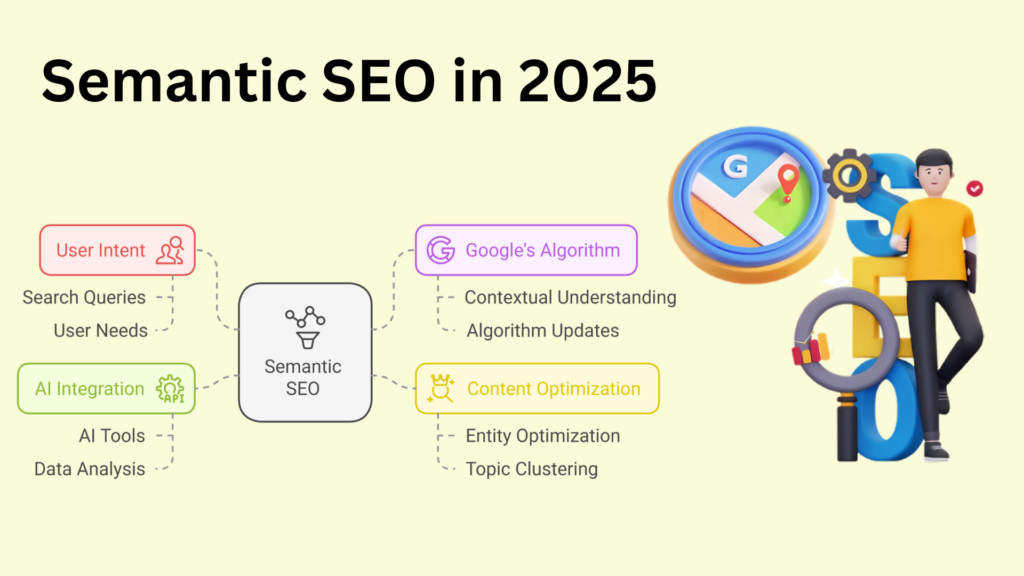Table of Contents
Toggle
Semantic SEO in 2025 prioritizes user intent and context over traditional keywords. It involves optimizing content with related topics, synonyms, and entities to align with Google’s evolving algorithms like BERT and MUM. Topic clustering, understanding search intent, and entity optimization are key strategies. This approach ensures content relevance and improves search rankings by focusing on comprehensive, user-centric information.
What is Semantic SEO?
At its core, Semantic SEO is about optimizing content in a way that aligns with the deeper intent behind search queries. It’s more than just focusing on keywords; it’s about delivering content that provides value and answers real user needs. Semantic SEO allows search engines to interpret the context and meaning behind content, improving rankings and enhancing relevance for both the search engine and users.
For businesses, this shift provides an opportunity to refine content strategies. By integrating entities, optimizing for search intent, and utilizing topic clustering, your content becomes more likely to align with what Google’s algorithm is actively rewarding.
The Role of Google’s Algorithm Updates
Google’s algorithm has been progressively moving towards understanding not just keywords, but also the broader context of search queries. Semantic SEO strategies align directly with Google’s evolving preferences, which are shifting towards more natural, intuitive ways of understanding content.
In 2025, expect to see more emphasis on how content relates to a user’s intent rather than the exact match of keywords. This shift presents both a challenge and an opportunity: adapt your content to meet these demands, and you’ll see improved visibility across the board.
Why Search Intent Matters
Search intent is the cornerstone of Semantic SEO. Whether a user is looking for information, seeking a specific product, or simply trying to solve a problem, understanding that intent allows you to create content that answers these needs effectively. By aligning your content with what the user is truly looking for, your chances of ranking higher increase substantially.
When you focus on search intent, you move beyond simply matching keywords. Instead, you become a resource for your audience, leading to better user engagement and satisfaction.
Topic Clustering and Entity Optimization
One of the most powerful tools in Semantic SEO is topic clustering, which involves grouping related content together to signal expertise and depth on a particular subject. Google values sites that show authority through related topics and subtopics, so building these clusters around core themes makes your content more valuable to both search engines and users.
Entity optimization refers to the process of ensuring that your content is linked to and accurately represents entities—people, places, and things. By aligning content with recognized entities, you increase your authority and contextual relevance. For example, if your business operates in real estate, associating your content with relevant entities like neighborhoods, cities, or key market players can signal authority and improve rankings.
The Future of Semantic SEO: AI Integration
Artificial Intelligence (AI) is becoming integral to search engines, making Semantic SEO even more crucial. AI can analyze vast amounts of data and interpret search queries with remarkable precision, allowing search engines to provide users with answers based on meaning, not just keywords.
For businesses, this means that AI-powered optimization tools can help analyze content in real-time, enabling you to adapt your strategy and stay ahead of algorithm changes.
Actionable Insights
- Audit Your Content: Begin by auditing your existing content for alignment with search intent. Is it addressing the underlying needs of users, or is it simply focused on surface-level keyword optimization?
- Implement Topic Clustering: Create pillar pages that serve as hubs of information, linking to in-depth articles that expand on related subtopics. This strategy not only enhances SEO but also improves the user experience.
- Optimize for Entities: Use structured data to help search engines better understand your content and its connections to real-world entities. This will help position your content as authoritative within your niche.
- Monitor Google’s Updates: Stay informed on Google’s algorithm changes and adjust your strategies accordingly. Following these updates allows you to make proactive adjustments to your content before they impact your rankings.
Take the Next Step
Incorporating Semantic SEO into your digital strategy in 2025 will require a shift in how you think about content. Rather than simply focusing on keywords, consider how you can align with search intent, build topical authority through clustering, and optimize for entities. By adopting these strategies now, you position your business for long-term success in the increasingly competitive digital space.
Start implementing Semantic SEO today and get ahead of the curve. This is your opportunity to ensure that your content resonates with users, aligns with Google’s evolving algorithms, and drives sustained growth for your business.
